DNA REPLICATION
DNA replication is a process whereby the exact copies of DNA (replicable) are produced by the old DNA molecules.
Significance
of DNA replication:-
(i) Since it occurs prior to the nuclear division, DNA replication ensures that all newly formed cells have the same amount of DNA.
(ii) It ensures sameness and constancy of hereditary materials of the cells.
(iii) Occasional mistakes during DNA replication, results into genetic variations hence evolution.
(iv) If evidence mistake attracts uracil instead of thymine. RNA is constructed not DNA. This occurs when the enzyme fails to recognize the methyl group of uracil.
Mechanism of DNA replication:-
The two strands of a DNA unwind and separating thus acting as temperature to which a complementary set of nucleotides would attach by base pairing. In this way each original molecule of DNA give rise
to two copies with identical structures. In the presence of ATP an enzyme DNA polymerase links free DNA to form complementary bases.The unwinding of DNA, double helix is controlled by the enzyme
helicase. DNA polymerase then move along the strand resulting formation of complementary bases and hence a free nucleotide and finally extending new stand of DNA. As the enzymes continue to move
along one base at a time, the new DNA strand grows. This is called continuous replication in which one strand is copied before another strand.
The formation (copying) of another strand involves movement of DNA polymerase away from unwinding enzyme. This results in the small gaps being left at some points along the newly constructed DNA stand. These gaps are then sealed by an enzymes DNA ligase. This is called Discontinuous replication.
Semi – conservative replication
- In this method of replication, each newly formed double helix retains (conserves) of the two strands of the original DNA double helix.
-
That is in each of the newly constructed DNA molecules, there is an old and new strand.
Illustration:-
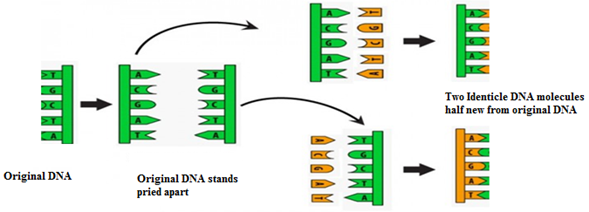
- A representative portion of DNA, which is about to undergo replication is shown.
- DNA polymerase causes the two strands of the DNA to separate.
- The DNA polymerase completes the splitting of the strand. Meanwhile free nucleotides are attracted to their complementary bases.
- Once the nucleotides are lined up joined together. The remaining unwinded bases continue to attract these complementary nucleotides.
- Finally the nucleotides are joined to form a complete polynudeotide chain. In this way two identical strands of DNA are formed. As each strand retains half of the original DNA material, this method of replication is called Semi – conservative method.
edu.uptymez.com
The tree theories of DNA replication illustrated
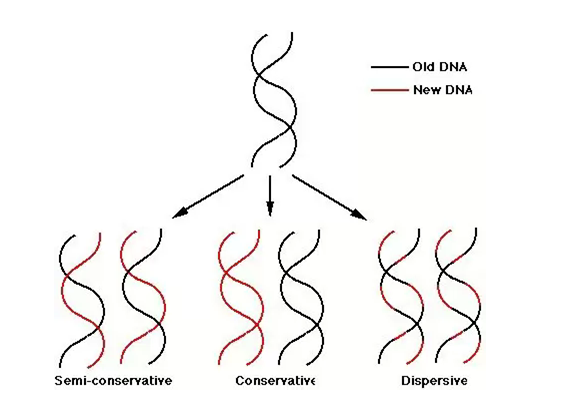
- Differences between DNA and RNA:-
edu.uptymez.com
| DNA | RNA | |
| Double stranded polynucleotide molecule | – Single stranded polynucleotide molecule. | |
| The pentose sugar is deoxyribose | – The pentose sugar is ribose | |
| The pyramidine base is Thymine | – The pyramidine base is uracil. | |
| It is found in molecules | – It is found in the cytoplasm | |
| It is constant in the cell | – The amount of RNA is variable | |
| It is more stable | – It is less stable. | |
| It has high molecular mass | – It has low molecular mass. | |
| The ratio of ‘A’ to ‘T’ and ‘G’ to ‘C’ is always 1. | – The ratio of ‘A’ to ‘U’ and ‘G’ to ‘C’ is variable | |
| Only one basic form, but with an infinity variety within that form. | – Three basic forms, messenger, transferred and ribosomal RNA | |
| Treatment | Stay exist temporary for short period |
edu.uptymez.com
Study Questions:-
1. (a) What is DNA replication?
(b) Describe the mechanism of the process by which a DNA molecule is produced and explain why this is called a semi-conservative process
(c) Summarize the structural differences between DNA and RNA.
2. Summarize the structure differences between DNA and RNA
The nature of genes:-
What are genes?
Mendel defined gene as a unit of inheritance. This is an acceptable definition of gene but it does not tell us anything about the physical nature of gene.
Below are ways of overcoming this objection.
(i) A unit of recombination
It was shown that a gene was the shortest segment of a chromosome which is separated from adjacent segments by crossing over.
This definition regards gene as the specific region of chromosome determining a district chromosome in the organism.
(ii) A unit of function
It is known that genes are codes for proteins;
Therefore a gene is the DNA code for polypeptide.
Since some proteins are made up of more than one polypeptide chain and are coded by more than one gene.
The genetic code
The genetic code is the relationship between nitrogenous bases on the DNA and the acids.
It was suggested that the genetic information which passed from generation to and which controlled the activities of the cell, might be stores in the sequence for the production of protein molecules it become clear that these sequence of in the DNA must be a code for the sequence of amino acids in protein molecules relationship between bases and amino acids is known as the genetic code.
In other words the genetic code is a means by which the genetic information.
DNA controls the manufacture of specific proteins, by the cells.
The problems remained were to demonstrate that a base code consisted to break the code and to determine how the code is translated in to the amino acid sequence of a protein molecule.
The code is triplet code.
There are four bases in the DNA molecules, Adenine (A), Guanine (G), Thymine (T) and Cytosin.
Each base is a part of nucleotide and the nucleotides are arranged as a polynucleotide chain (strand). The sequence of base indicated by their first letters (alphabets) are responsible for carrying the code that
results in the synthesis of potentially infinite number of different protein molecules.
There are 20 common amino acids used to make protein and that the base in the DNA must code for. If one base determined the position of a single amino acid in the primary structure of a protein, the
protein could have four different amino acids. If a combination of base pairs coded for each amino acid then 16 acids could be specified into the protein molecule.
Only a code composed of three bases could incorporate all 20 amino acids into the structure of protein molecules.
It was therefore proved that the code is indeed a triplet code, meaning that three bases is the code for one amino acid.
Problems.
- Using different pairs of the bases A, G, T and C list the 16 possible combinations of bases that can be produced.
edu.uptymez.com
Answer:-
| Base | A | G | T | C |
| A | AA | AG | AT | AC |
| G | GA | GG | GT | GC |
| T | TA | TG | TT | TC |
| C | CA | CG | CT | CC |
edu.uptymez.com
2. If four bases used singly would code for four amino acids, pairs of bases code for the 16 amino acids and triplets of bases code for 64 amino acids, deduce a material to expression to explain this.
Answer:-
4 bases used once = 4 x 1 = 4
4 bases used twice = 4 x 4 = 42 = 16
4 bases used thrice = 4 x 4 x = 64
The mathematical expression is Xy
Where: X = Number of bases and
Y = Number of bases used.
– It is thus a combination of three nitrogenous bases a three lettered ward of AGC, AUA, GCA etc.
Features (Characteristics) of the genetic code:-
1. It is a triplet of bases in the polynucleotide chain codes for an amino in the polypeptide chain.
2. The genetic code is degenerate i.e A given amino acid can be coded for by more to one code and (Codons-complementary triplets in the mRNA).
Example:
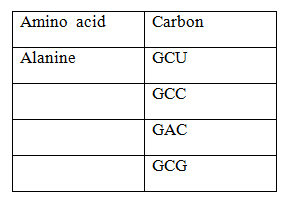
3. The genetic code is universal i.e. the same triplet codes for the same amino acids all organisms.
4. The genetic code can be punctuated i.e. It has got the ‘start’ and ‘end’ signals.
5. The genetic code is non-over lapping. E.g. If the base sequence is ACAGAGUCGGAC, then this will be read as ACA/GAG/UCG/GAC and not ACA / CAG / AGA.
6. The genetic code sequence has got no camma e.g. AAU, GCG, GAC, etc. This is because the bases are continuously sequenced on the DNA or RNA strand.
Note: The type of code where the number of amino acids is less than the number of codons is termed as degenerate.
Nonsense codons – These codons do not code for amino acids, they pregimably mark the end point of 2 chains. They act as stop signals for the termination of polypeptide chains during translation.
PROTEIN BIOSYNTHESIS. ‘DNA makes RNA and RNA
makes Protein’
-
Protein synthesis is a mechanism by which protein molecule is constructed by joining the amino acids with the peptide bonds according to the instruction in the mRNA coded from DNA.
1. Synthesis of amino acids.
2. Transcription (Formation of mRNA).
edu.uptymez.com
3. Amino acid activation.
4. Translation.
The site for protein synthesis is the ribosome.
These protein synthesized may have structural role such as Keratin and collagen, or a functional role such as insulin, fibrinogen and mostly important enzymes which are responsible for controlling all metabolism. It is the particular range of enzymes that determines what type of cell it becomes. This is the way in which DNA controls the activities of a cell.
The instructions and information for the manufactures of enzymes and all other proteins are located in the DNA. However, the actual synthesis of protein occurs in the ribosomes in the cytoplasm. Therefore a mechanism had to exist for carrying the genetic information’s from the nucleus to the cytoplasm. This link was from messenger RNA.
Adaptations of the ribosome to protein synthesis
1. Presence of appropriate enzymes that catalyze the synthesis of polypeptide bonds between the amino acids.
2. Presence of receptor site for messenger RNA attachment.
3. Presence of rRNA for attracting other types of tRNA towards the ribosome.
4. Ability to read and ‘translate’ the message contained in the codes of mRNA.
Mechanism of protein synthesis:-
There are four main stages in the synthesis of protein:-
-
1. Synthesis of amino acids:-
In plants, the formation of amino acids occurs in mitochondria and chloroplast in a series of stages:
(a) Absorption of nitrates from the soil.
(b) Reduction of those nitrates to the amino group (NH2).
(c) Combination of those amino groups with a carbohydrate skeleton (eg. α – ketoglutarate from Krebs cycle).
(d) Transfer of the amino group from one carbohydrate skeleton to another by a process called transamination.
Animals usually obtain their acids from the food they ingest, although they have capacity to synthesize their own non- essential amino acids.
2. Transcription (formation of mRNA).
- This is a mechanism by which the base sequence of a section of DNA representing gene, is converted into a complementary base sequence of mRNA.
-
In this process a complementary mRNA copy is made from a specific region of the molecule which codes for a polypeptide.
Mechanism of transcription
A specific region of the DNA molecule, called Cistron, unwinds. This unwinding is a result of hydrogen bonds between base pairs in the DNA double helix being broken. This exposes the bases along each strand and one of these strands is selected as a template against which mRNA is constructed.
This mRNA molecule is formed by linking free nucleotides under the influence of RNA polymerase and according to the rules of base pairing between DNA and R
Table to show the RNA bases which are complementary to those of DNA:-
edu.uptymez.com

When the mRNA molecule has been synthesized they leave the nucleus via the nuclear pore and carry the genetic code to the ribosomes. Along the mRNA is sequence of triplet codes which have been determined by the DNA. Each triple called a codon.
When sufficient numbers of mRNA molecules have been formed from the gene the RNA polymerase molecule leave the DNA and the two strands ‘Zip up” reforming the double helix.
Illustration:-
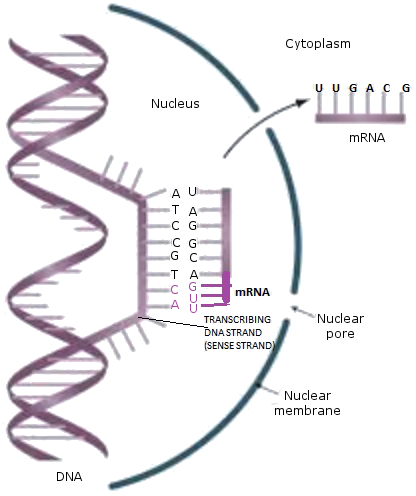
3. Amino acid activation
Activation is the process by which amino acids combine with tRNA using energy from ATP. Each type of tRNA binds with the specific amino acid which means there must be at least 20 types of tRNA.
Each type differs among other things in the composition of a triplet of bases called terminates in the CCA. It is to the free end that the individual amino is not known. The tRNA molecules with attached amino acids form an amino acid tRNA complex known as aminoacyl-tRNA and their formation is under the enzyme aminoacyl-tRNA synthetase. The combination now moves towards the ribosome.
Illustration:-
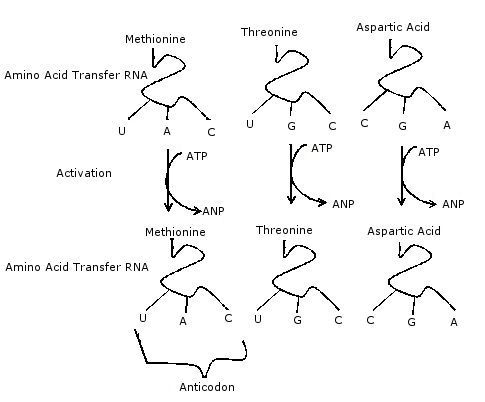
4.Translation.
- Translation is the mechanism by which the sequence of bases in an mRNA molecule converted into a sequence of amino acids in a polypeptide chain.
- It occurs on ribosomes.
- Several ribosomes may become attached to a molecule of mRNA like bodies on string end a whole structure is known as polyribosome or polysome.
- The advantage of such an arrangement is that it allows several polypeptides to be synthesized at the same time.
- The first two mRNA codons (a total of 6 bases) enter the ribosome. The first codon binds the aminoacyl–tRNA molecule having the complemetary ‘anticodon’ and which is carrying the first amino acid (Usually – methionine) of the polypeptide being synthesized.
- The second codon then also attracts an amino acyl-tRNA molecule showing the complementary anticodon.
- The function of the ribosome is to hold in position the mRNA, tRNA and the association enzymes controlling the process until a peptide bond form between the adjacent amino
- acids.
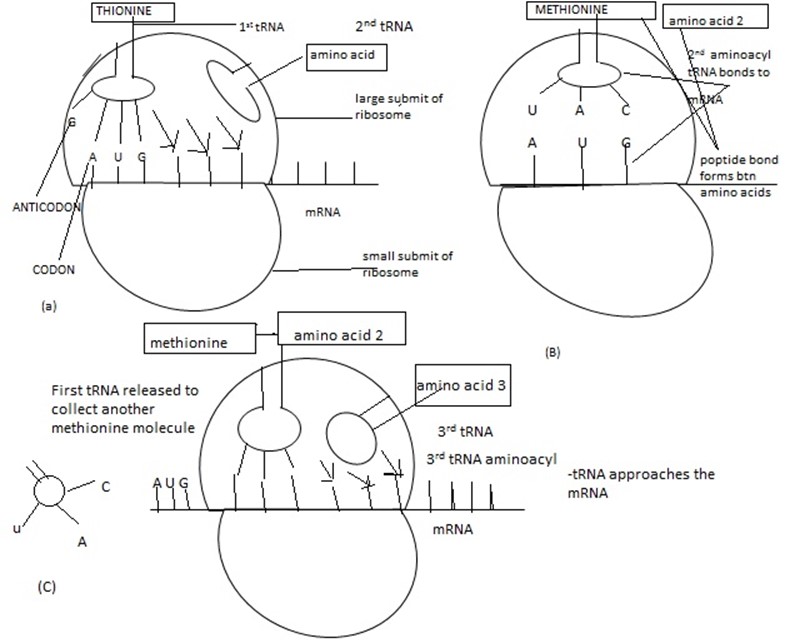
- Once the new amino acid has been added to the growing polypeptide chain, the ribosome moves one codon along the mRNA. The tRNA molecule which was previously attached to the polypeplide chain now leaves the ribosome and passes back to the cytoplasm to be reconverted into a new aminoacyl – tRNA molecule.
-
This sequence of ribosome ‘reading’ and ‘translating’ the mRNA code continues until it comes to a codon signaling ‘stop’. These terminating codons are UAA,UAG, and UGA. At this point the polypeptide chain, now with its primary structure as determined by DNA, leaves the ribosome and translation is complete. The main steps involved in translation may be summarized under the following headings;-
- Binding of mRNA to ribosome.
- Amino acid activation and attachment to tRNA.
- Polypeptide chain initiation.
- Chain elongation.
- Chain termination.
- Fate of mRNA.
edu.uptymez.com
The polypeptides so formed must now be assembled into proteins. This may involve the spiralling of the polypeptides to give a secondary structure, its folding to give a tertiary structure and its combination with other polypeptides and or prosthetic group to give a quatenary structure.
If the ribosome is attached to ER (rough ER) the protein enters the ER to be transported.
Question.(a) Describe how a single stand of mRNA is being constructed from one of the strands of DNA.
(b) If the base sequence on the portion of DNA strand is AGTCCACCATAA,
(i) What is the base sequence on the portion of mRNA constructed by this portion?
(ii) How many amino acid molecules are there in the base sequence given above?
SOLN
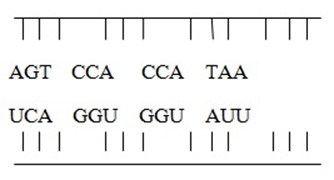
- Thus the base sequence on the mRNA will be UCAGGUGGUAAU
edu.uptymez.com
- Since there are four triplets each responding a single amino acid, then there will be four amino acids.
edu.uptymez.com
Introns and exons.
It was discovred that the DNA of eukaryotic gene is longer than its corresponding mRNA. It should be the same length because the messenger RNA is a direct copy discovered that immediately after the mRNA is made, certain sections of the molecule out before it is used in transaction. The sections of the gene that code for the unused pieces of RNA are called Introns. The remaining sections of the gene the code for the protein and are called exons.
Summary:
Eukaryotic genes contain regions called Introns which do not code for the amino. The parts of the genes that code for amino acids are called exons.